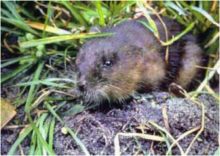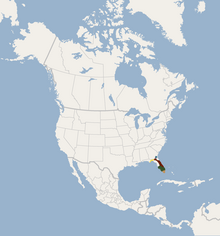Round-tailed muskrat
| Round-tailed muskrat Temporal range: Middle Pleistocene – Recent | |
|---|---|
 | |
Conservation status | |
| Scientific classification | |
| Domain: | Eukaryota |
| Kingdom: | Animalia |
| Phylum: | Chordata |
| Class: | Mammalia |
| Order: | Rodentia |
| Family: | Cricetidae |
| Subfamily: | Arvicolinae |
| Tribe: | Ondatrini |
| Genus: | Neofiber True, 1884 |
| Species: | N. alleni |
| Binomial name | |
| Neofiber alleni True, 1884 | |
 | |
| Geographic range N.a.alleni N.a.apalachicolae N.a.exoristus N.a.nigrescens N.a.struix | |
The round-tailed muskrat (Neofiber alleni) is a species of rodent in the family Cricetidae, sometimes called the Florida water rat.[2] The species is monotypic in the genus Neofiber. It is found only in the southeastern United States, where its natural habitat is swamps.
Description
The round-tailed muskrat is a semiaquatic and nocturnal species native to the southeastern United States.[3] Limited sexual dimorphism is seen among round-tailed muskrats, with female adults weighing an average of 262 grams (9.2 oz) and male adults measuring at a slightly heavier average of 279 grams (9.8 oz).[3] The round-tailed muskrat feeds on emergent aquatic grasses,[4] including aquatic plant stems, seeds, and roots, to sustain its herbivorous lifestyle.[5] The most prominent predators of the round-tailed muskrat are marsh hawks and barn owls, but most predation occurred when the round-tailed muskrats were found outside their normal territory, having been displaced by floods.[3] The pelage of a newborn round-tailed muskrat varies from gray to ash-gray. Adults have a brown pelage with pale fur on the belly. This change in coat color is the result of a juvenile molt (between 7 and 30 days post partum) and a subadult molt (between 35 and 50 days post partum). Molting in round-tailed muskrats has been observed throughout the year, but is more prevalent during the autumn.[3]
Distribution
This muskrat is found through much of Florida and into southeastern Georgia, with the exception of northeastern Florida.[6] This distribution is consistent with round-tailed muskrat fossils found in several Florida locations from the late Pleistocene.[7] It is also consistent with the range of the muskrat (Ondatra zibethicus), who is absent from areas where the round-tailed muskrat inhabits, due to filling the same ecological niche. Population densities of round-tailed muskrats average between 100 and 120 animals per acre of land.[3]
Habitat
Large, high-quality wetland habitats in Florida and southeastern Georgia that have well-connected patches are preferred.[8] Land areas that experience high grazing pressure from cattle are less likely to house many (if any) animals due to the negative effect grazing has on wetland grass available to round-tailed muskrats.[8] In addition to actively selecting habitats to which to disperse, round-tailed muskrats shift among 10–15 rest sites within their home habitat ranges.[9] They live slightly above water level in their wetland habitats. Their shelter consists of lodges, located on a layer of dense vegetation, that have been woven out of plant material, and they feed on feeding platforms located above water level.[10] Round-tailed muskrats have been described to be social mammals, but it has been suggested that they may live in colonies only when a shortage of suitable habitat occurs.[11]
References
- ^ Cassola, F. (2016). "Neofiber alleni". IUCN Red List of Threatened Species. 2016: e.T14520A22356567. doi:10.2305/IUCN.UK.2016-2.RLTS.T14520A22356567.en. Retrieved 15 November 2021.
- ^ "Florida water rat", Encyclopædia Britannica online, retrieved August 14, 2008
- ^ a b c d e Birkenholz, D. (1963). "A study of the life history and ecology of the round-tailed muskrat (Neofiber alleni True) in north-central Florida". Ecol. Monogr. 33 (3): 187–213. doi:10.2307/1942628. JSTOR 1942628.
- ^ Lefebre, L. W. and Tilmant, J. T. (1992). Round-tailed muskrat (Neofiber alleni). pp. 276–286 in Rare and endangered biota of Florida. Vol. I. Mammals (S. R. Humphrey, ed.). University Press of Florida, Gainesville.
- ^ Porter, R.P. (1953). A contribution to the life history of the water rat, Neofiber alleni. M.S. thesis, Univ. Miami.
- ^ Paul, J. R. 1967. Round-tailed muskrat in west central Florida. Quart. Jour. Florida Acad. Sci. 30:227–229.
- ^ Ray, C. E. 1957. A list, bibliography, and index of the fossil vertebrates of Florida. Florida Geol. Surv. Spec. Publ. 3:1–175
- ^ a b Schooley, R. L. & Branch, L. C. (2005). "Survey techniques for determining occupancy of isolated wetlands by round-tailed muskrats". Southeastern Naturalist. 4 (4): 745–756. doi:10.1656/1528-7092(2005)004[0745:STFDOO]2.0.CO;2. JSTOR 3878236. S2CID 53609796.
- ^ Schooley, R. L. & Branch, L. C. (2006). "Space use by roundtailed muskrats in isolated wetlands". Journal of Mammalogy. 87 (3): 495–500. doi:10.1644/05-MAMM-A-249R1.1. JSTOR 4094506.
- ^ Bergstrom, B.J., Farley, T., Hill, H.L., Jr., and Hon, T. (2000). Ecology and conservation of a frontier population of the roundtailed muskrat (Neofiber alleni). Occasional Papers of the North Carolina Museum of Natural Sciences 12:74–82
- ^ Hoogland, J. L. (1995). The black-tailed prairie dog: social life of a burrowing mammal. University of Chicago Press, Chicago, Illinois ISBN 0226351181
Sources
- Musser, G. G. and M. D. Carleton. 2005. Superfamily Muroidea. pp. 894–1531 in Mammal Species of the World a Taxonomic and Geographic Reference. D. E. Wilson and D. M. Reeder eds. Johns Hopkins University Press, Baltimore.
- Round-tailed muskrat, Field Guide to the Rare Animals of Florida
- v
- t
- e
- Kingdom: Animalia
- Phylum: Chordata
- Class: Mammalia
- Infraclass: Eutheria
- Superorder: Euarchontoglires
- Order: Rodentia
- Family: Cricetidae
| Arvicola (Water voles) |
|
|---|
| Alexandromys |
|
|---|---|
| Chionomys (Snow voles) |
|
| Hyperacrius (Voles from Pakistan) |
|
| Lasiopodomys |
|
| Lemmiscus |
|
| Microtus (Voles) |
|
| Neodon (Mountain voles) |
|
| Proedromys |
|
| Stenocranius |
|
| Volemys |
|
(Collared lemmings)
| Dicrostonyx |
|
|---|
(mole voles)
| Ellobius (Mole voles) |
|
|---|
(Steppe lemmings)
| Eolagurus |
|
|---|---|
| Lagurus |
|
(Lemmings)
| Lemmus (True lemmings) |
|
|---|---|
| Myopus |
|
| Synaptomys (Bog lemmings) |
|
| Alticola (Voles from Central Asia) |
|
|---|---|
| Caryomys |
|
| Eothenomys (Voles from East Asia) |
|
| Clethrionomys (some Red-backed voles) |
|
| Craseomys (other Red-backed voles) |
|
| Neofiber |
|
|---|---|
| Ondatra |
|
| Dinaromys |
|
|---|
| Arborimus (Tree voles) |
|
|---|---|
| Phenacomys (Heather voles) |
|
| Prometheomys |
|
|---|










